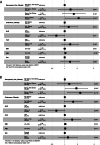Impact on survival of sarcopenia, systemic inflammatory response and anthropometric factors after pancreatectomy for resectable pancreatic adenocarcinoma
- PMID: 39232731
- PMCID: PMC11376042
- DOI: 10.1186/s12957-024-03510-6
Impact on survival of sarcopenia, systemic inflammatory response and anthropometric factors after pancreatectomy for resectable pancreatic adenocarcinoma
Abstract
Introduction: Pancreatic adenocarcinoma (PDAC) is becoming a public health issue with a 5-years survival rate around 10%. Patients with PDAC are often sarcopenic, which impacts postoperative outcome. At the same time, overweight population is increasing and adipose tissue promotes tumor related-inflammation. With several studies supporting independently these data, we aimed to assess if they held an impact on survival when combined.
Methods: We included 232 patients from two university hospitals (CHU de Lille, Institut Paoli Calmette), from January 2011 to December 2018, who underwent Pancreaticoduodenectomy (PD) for resectable PDAC. Preoperative CT scan was used to measure sarcopenia and visceral fat according to international cut-offs. Neutrophil to lymphocyte (NLR) and platelet to lymphocyte ratios (PLR) were used to measure inflammation. For univariate and multivariate analyses, the Cox proportional-hazard model was used. P-values below 0.05 were considered significant.
Results: Sarcopenic patients with visceral obesity were less likely to survive than the others in multivariate analysis (OS, HR 1.65, p= 0.043). Cutaneous obesity did not influence survival. We also observed an influence on survival when we studied sarcopenia with visceral obesity (OS, p= 0.056; PFS, p = 0.014), sarcopenia with cutaneous obesity (PFS, p= 0.005) and sarcopenia with PLR (PFS, p= 0.043). This poor prognosis was also found in sarcopenic obese patients with high PLR (OS, p= 0.05; PFS, p= 0.01).
Conclusion: Sarcopenic obesity was associated with poor prognosis after PD for PDAC, especially in patients with systemic inflammation. Pre operative management of these factors should be addressed in pancreatic cancer patients.
Keywords: Obesity; Pancreatic adenocarcinoma; Sarcopenia; Systemic inflammatory response.
© 2024. The Author(s).
Conflict of interest statement
The authors declare no competing interests.
Figures




References
-
- Gordon-Dseagu VL, Devesa SS, Goggins M, Stolzenberg-Solomon R. Pancreatic cancer incidence trends: evidence from the Surveillance, Epidemiology and End Results (SEER) population-based data. Int J Epidemiol. 2018;47(2):427–39. 10.1093/ije/dyx232. PMID: 29149259; PMCID: PMC5913617. 10.1093/ije/dyx232 - DOI - PMC - PubMed
MeSH terms
LinkOut - more resources
Full Text Sources
Medical

